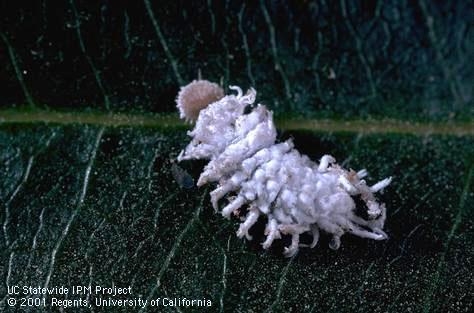Biological control is the management of pests and their damage by the beneficial action of parasites (parasitoids), pathogens, and predators. These beneficial organisms, collectively, are named natural enemies.
Conserving (or protecting) and releasing natural enemies are important components of integrated pest management (IPM). In most situations, employing practices that conserve natural enemies is more effective, and less expensive and time consuming, than purchasing and releasing them.
Learn about the specific situations where purchasing and releasing parasites and predators can increase the effectiveness of biological control. Before purchasing natural enemies, consult the University of California (UC) IPM Pest Management Guidelines for that crop to learn whether UC research has shown that releasing them is effective. Some natural enemies on the market have never been demonstrated to effectively control any agricultural pest in California.
Obtaining Natural Enemies
Natural enemies can be purchased directly from various producers (companies that rear them) and suppliers (companies that purchase from producers and repackage and resell them). Some sources of parasites and predators are members of the Association of Natural Biocontrol Producers (ANBP). All ANBP members formally agree to a code of ethics and standardized methods.
Natural enemies purchased by users are commonly delivered via shipping services. Purchase parasites and predators only from in-state providers. It is illegal to obtain insects and other arthropods outside of California and carry or have them shipped across state lines without a permit from agricultural officials. Some pest control advisers and pest scouts will procure and release natural enemies as a service for growers.
Methods for Releasing Natural Enemies
Two methods for releasing natural enemies are inoculation and inundation:
- Inoculation—relatively few natural enemies are released. The offspring of these natural enemies provide biological control, not the individuals released.
- Inundation—large numbers of natural enemies are released, often several times over a growing season. The natural enemies released, and possibly their offspring, provide biological control.
The mealybug destroyer is an example of a natural enemy that is only released through inoculation—at relatively low numbers once per year early in the growing season. Aphytis melinus and Trichogramma parasites are released by inundation—at regular intervals over the growing season—to control California red scale and eggs of pest moths, respectively. Both inoculation and inundation can be used with predatory mites, depending on the situation.
Releasing Natural Enemies Effectively
Releasing natural enemies is most likely to be effective in situations where: 1) University of California researchers or other pest management experts have previously demonstrated success and 2) some level of pests and their damage can be tolerated in that crop. Desperate situations are not good opportunities for releasing natural enemies. Pests or their damage may already be too widespread for any release of parasites or predators to prevent economic loss of crop quality or quantity.
Increase the likelihood that natural enemy releases will be effective by
- Accurately identifying the pest and its natural enemies.
- Learning about the biology of the pest and its natural enemies.
- Releasing the appropriate natural enemy life stage and species.
- Releasing when the pests' vulnerable life stage(s) are present and at numbers that can be controlled by natural enemy releases.
Natural enemies are unlikely to be effective when released as if you were applying a pesticide. Instead, anticipate pest problems and begin making releases before pests are too abundant or economic damage is imminent.
- Remember that natural enemies are living organisms that require food, shelter, and water. Protect them from extreme conditions. For example, release them at night or early in the day during hot weather.
- Avoid applying broad-spectrum, residual (persistent) insecticides and miticides, and in some situations certain systemic or other pesticides, before or after releasing natural enemies. When needed, use pesticides selectively. For example, spot spray only where pests are abundant but localized.
Common reasons for the lack of satisfactory biological control after releases include the
- Application of broad-spectrum, residual insecticides, or in some situations systemic or other pesticides, prior to or after a release.
- Incorrect timing of release.
- Release of the wrong natural enemy for the pest situation.
- Release of a natural enemy species that is known to be ineffective.
For information on the use of biological control, see the UC IPM Pest Management Guidelines for your crop and specific pests. Most crops have a table called “Relative Toxicities of Insecticides and Miticides to Natural Enemies and Honey Bees” in the “General Information” section. Use these resources to guide pesticide selection to conserve natural enemies and improve biological pest control.
More Information
- Association of Natural Biocontrol Producers, Clovis, CA
- Grower Guide: Quality Assurance of Biocontrol Products (pdf), Vineland Research and Innovation Centre, Ontario
- Insectary Plants
- Natural Enemies Gallery
- Natural Enemies Handbook: The Illustrated Guide to Biological Pest Control
- Protecting Natural Enemies and Pollinators
- UC IPM Pest Management Guidelines
This Page is duplicated from the UC Integrated Pest Management website - https://www2.ipm.ucanr.edu/agriculture/natural-enemy-releases-for-biological-control-of-crop-pests/
Photo of predatory" mealybug destroyer" or Cryptolaemus
